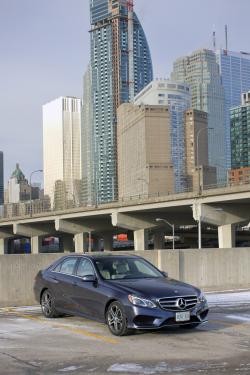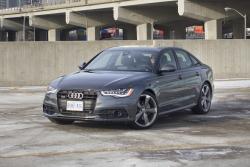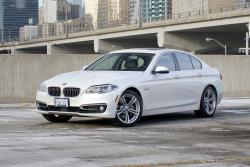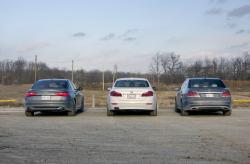    2014 Mercedes-Benz E 250 Bluetec 4Matic, 2014 Audi A6 TDI Quattro, 2014 BMW 535d xDrive. Click image to enlarge |
Powertrain, Jeff Wilson
These three mid-size German sedans combine to offer Canadian consumers fifteen different engine choices. Each one can be spec’ed with everything from a sensible and efficient four-cylinder mill, to a boosted six-cylinder all the way up to a variety of exhilarating turbo V8s. Power ranges from 195 hp to darn near three times that figure (for darn near three times the cost when fully optioned).
Celebrating the awakening of North American acceptance for diesel engines, these luxury car makers have finally offered us state-of-the-art oil-burning power plants in their mid-size sedans and each one is simply magnificent.
Mercedes-Benz has been kind enough to share its E-Class diesels for decades with a mostly ungrateful market on this side of the Atlantic. This E 250 BlueTec is the smallest and least powerful engine in our trio. With only four cylinders (versus six for the other two) and just over 2.1L of displacement, the diesel variant represents the entry-level engine and trim level for the E-Class.
The four-cylinder BlueTec diesel feels anything but entry level. With an impressive 369 lb-ft of torque available between 1,600 and 1,800 rpm, the Benz (propelling the lightest car in the lot by nearly 50 kg) had no trouble playing with its more powerful competitors when we took to back-road hustling. Mercedes claims a 0–100 km/h time of 7.9 seconds, but thanks to that torque and well-matched gearing, it feels quicker than that. Still, with only 195 horsepower and a slightly coarser engine note, as good as it is, the Benz’s four-pot diesel feels a little outclassed against its larger opponents.
Audi’s 24-valve, direct-injected, turbo 3.0L V6 diesel is a smooth operator – and not just by diesel standards. Not many years ago Audi’s top-level V8s would’ve wished to be this creamy and could only dream of this engine’s 428 lb-ft of torque. With these figures, the Audi TDI (a mid-level entry for the A6 line) achieves a claimed 0–100 km/h in 5.7 seconds – quickest in our test.
When paired with the sensational eight-speed gearbox found in an increasing number of luxury machines these days, the result reminds drivers that Audi is the company that has won Le Mans several times with diesels, and singlehandedly squashed the notion that oil-burners can’t be sporty.
Although BMW has been producing some exquisite V8s (and more recently some industry-leading turbo-fours), the Munich company is best loved for its mastery of inline-sixes. The 535d’s engine stays true to this legendary prowess but sips diesel instead of petrol. The Bimmer’s 3.0L, 24-valve I6 (also mated to the prolific eight-speed) provides a top-of-this-group 255 horsepower and second-place 413 lb-ft of torque.
As the heaviest car in this group by 35 kg, the all-wheel-drive 5 Series is rated at six seconds flat to 100 km/h – well within the respectable realm of legitimate performance sedans. What’s more, that mountain of torque is available at only 1,500 rpm, meaning the 535 is a willing passing partner whenever you need it to be.
And if the Audi’s diesel is creamy smooth, the Beamer’s is slick, melted butter, thanks no doubt to its inline-six format helping passengers forget that diesels are supposed to be coarse and noisy. Plus with a deeper voice, the BMW sounds the best of this lot.
For these reasons, the BMW’s engine is our favourite.











